Foreign relations and military
Since its independence in 1947, India has maintained cordial relationships with most nations. It took a leading role in the 1950s by advocating the independence of European colonies in Africa and Asia.[59] India was involved in two brief military interventions in neighboring countries - Indian Peace Keeping Force in Sri Lanka and Operation Cactus in Maldives. India is a member of the Commonwealth of Nations and a founding member of the Non-Aligned Movement.[60] After the Sino-Indian War and the Indo-Pakistani War of 1965, India's relationship with the Soviet Union warmed at the expense of ties with the United States and continued to remain so until the end of the Cold War. India has fought three wars with Pakistan, primarily over Kashmir but it also facilitated the creation of Bangladesh in 1971.[61] Additional skirmishes have taken place between the two nations particularly in 1984 over Siachen Glacier and in 1999 over Kargil.

In recent years, India has played an influential role in the SAARC, and the WTO.[63] India has provided as many as 55,000 Indian military and police personnel to serve in thirty-five UN peace keeping operations across four continents.[64] Despite criticism and military sanctions, India has consistently refused to sign the CTBT and the NPT, preferring instead to maintain sovereignty over its nuclear program. Recent overtures by the Indian government have strengthened relations with the United States, China and Pakistan. In the economic sphere, India has close relationships with other developing nations in South America, Asia and Africa.
India maintains the third-largest military force in the world, which consists of the Indian Army, Navy and Air Force.[9] Auxiliary forces such as the Paramilitary Forces, the Coast Guard, and the Strategic Forces Command also come under the military's purview. The President of India is the supreme commander of the Indian armed forces. India maintains close defence cooperation with Russia, France and Israel, who are the chief suppliers of arms. The Defence Research and Development Organisation (DRDO) has overseen the indigenous development of sophisticated arms and military equipment, including ballistic missiles, fighter aircrafts and main battle tanks, to reduce India's dependence on foreign imports. India became a nuclear power in 1974 after conducting an initial nuclear test, Operation Smiling Buddha and further underground testing in 1998. India maintains a "no first use" nuclear policy.[65] On 10 October, 2008 Indo-US civilian nuclear agreement was signed, prior to which India received the IAEA and NSG waivers, ending restrictions on nuclear technology commerce with which India became de facto sixth nuclear power in world.[66]


No comments:
Post a Comment